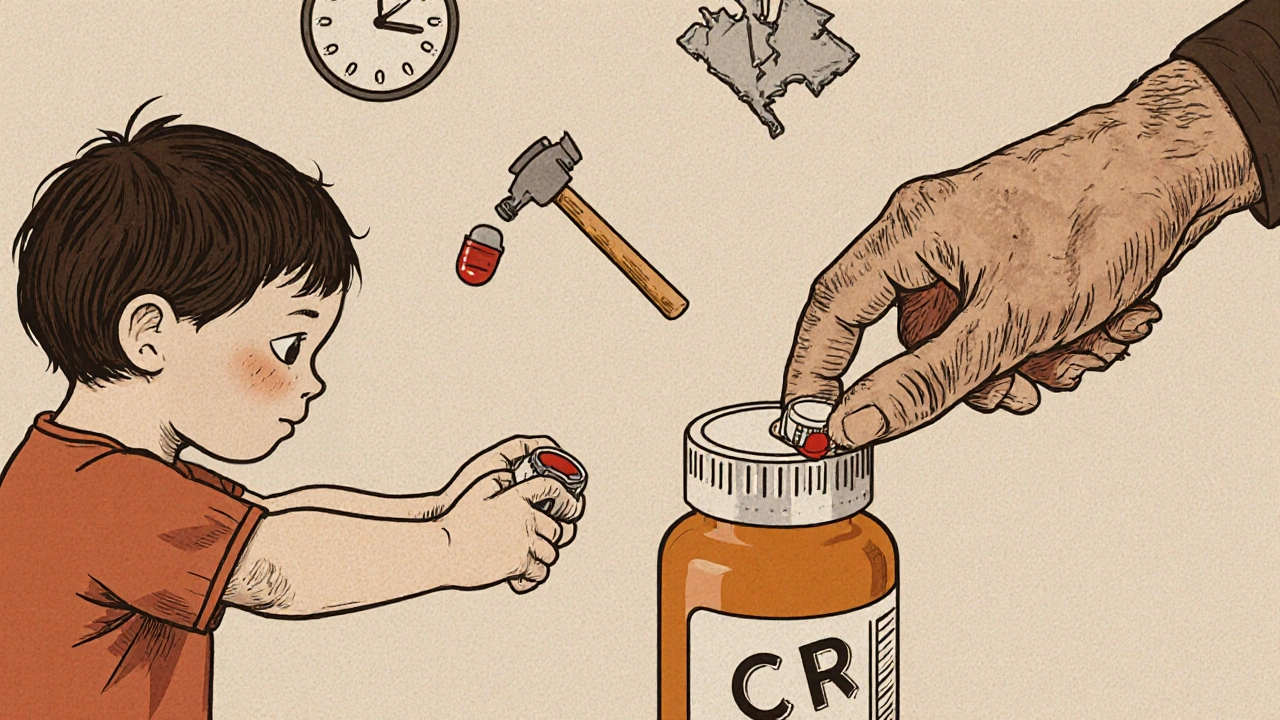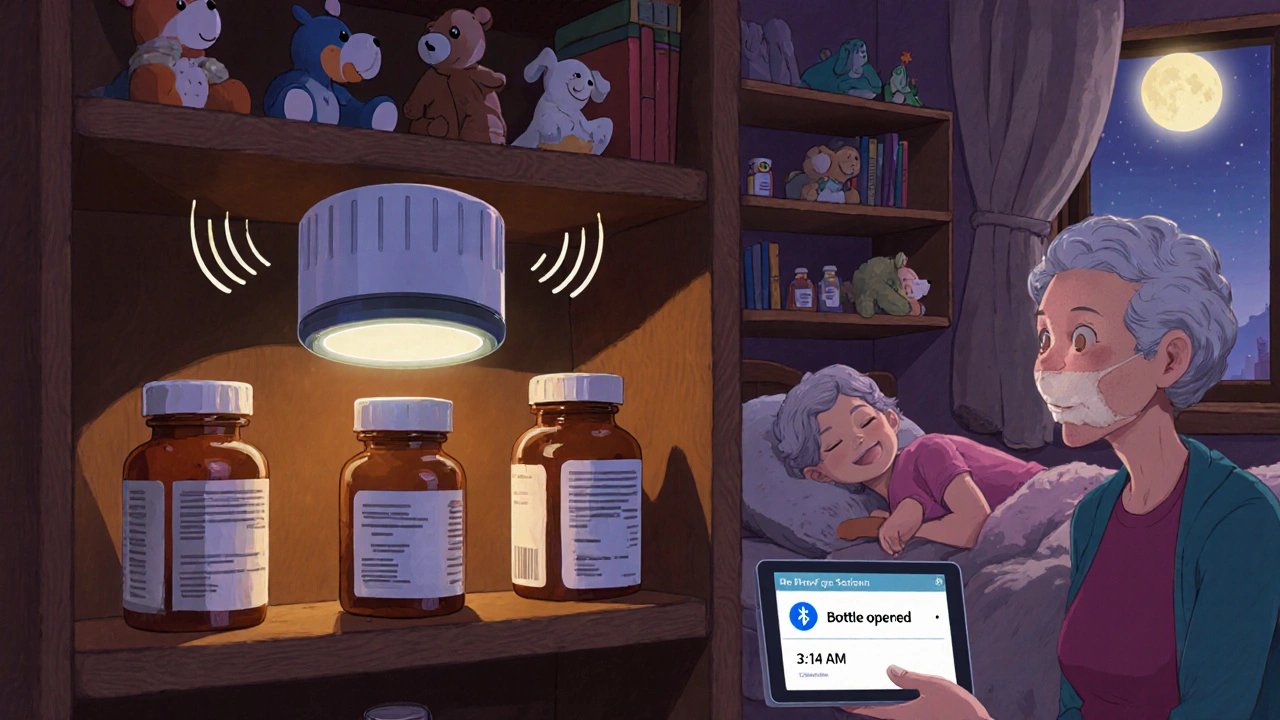Every year, thousands of young children accidentally get into medications they shouldn’t. It’s not because they’re curious little explorers-it’s often because the bottle wasn’t properly closed, or the cap was too easy to twist off. That’s where child-resistant containers come in. They’re not magic. They won’t stop every child. But they’ve saved lives. Since the 1970s, these special caps and containers have cut pediatric poisoning deaths by nearly half. If you have kids, grandkids, or even just visit a home with young children, understanding how these safety caps work-and how they sometimes fail-isn’t just helpful. It’s essential.
What Exactly Is Child-Resistant Packaging?
Child-resistant packaging, or CR packaging, is designed to make it hard for kids under five to open a medicine bottle in a short amount of time. But here’s the thing: it’s not child-proof. That’s a common mistake. No cap is 100% foolproof. The goal isn’t to create an unbreakable vault-it’s to slow kids down enough so an adult notices before something bad happens.
The U.S. government set the rules back in 1970 with the Poison Prevention Packaging Act (PPPA). Before that, 5,000 children died from accidental poisonings in just six years. Today, thanks to CR packaging, that number has dropped dramatically. The Consumer Product Safety Commission (CPSC) says these caps must stop at least 85% of kids aged 42 to 51 months from opening them within 10 minutes. That’s not a suggestion. It’s a legal requirement for most prescription and many over-the-counter medicines.
How Do These Caps Actually Work?
Most child-resistant caps use a simple but clever trick: they require two different motions at the same time. The most common is the push-and-turn design. You have to press down on the cap while twisting it. A child might twist it all day and never realize they need to push first. Other designs use squeeze-and-turn or interlocking parts that need fingers to move in opposite directions.
These caps aren’t made from fancy materials. They’re usually high-density polyethylene (HDPE), the same plastic used in milk jugs. But the threading inside is precision-engineered. The cap has to snap into place just right. It has to hold up to 50 openings and closings without wearing out. And it has to pass a second test: adults need to be able to open it easily.
That’s where senior-friendly design comes in. The CPSC requires that at least 90% of adults aged 50 to 70 can open and re-close the cap within five minutes. That’s a big deal. Many older people have arthritis or weak hands. A cap that stops a toddler might also stop your grandma. That’s why newer designs like Aptar Pharma’s Mini+cr system aim for 92% senior success while keeping child resistance above 90%.
Not All Medicines Are Created Equal
Some medications have stricter rules than others. Prescription drugs, especially controlled substances like opioids or ADHD meds, must always use CR packaging under DEA rules. But for over-the-counter medicines, it depends on the active ingredient. If a bottle contains more than 0.08 milligrams of imidazoline-a common ingredient in nasal decongestants-it needs a CR cap. Same goes for certain painkillers, antihistamines, and iron supplements.
Liquid medicines are trickier. About 39% of non-compliant packaging cases involve liquids. Why? Because they’re often sold in squeeze bottles or dropper tops that are easier for kids to open. Blister packs can help, but only if the foil requires at least 15 pounds of force to peel. Most standard blister packs don’t cut it.
Nasal spray pumps are the worst offenders. The CPSC says a simple spray nozzle isn’t enough. Even if the bottle has a CR cap, the pump itself can be opened by a determined child. That’s why only 22% of nasal sprays met CR standards before special spray pumps were developed. Now, newer models combine a CR overcap with a lock on the spray mechanism.

Why Do These Caps Still Fail?
Here’s the uncomfortable truth: most accidents happen because the cap was never closed right. In 2022, the CPSC recorded over 12,800 incidents where children got into medications. Of those, 73% happened because the cap was left loose, partially twisted, or put back on crooked. Parents think they closed it. They didn’t.
Another big problem? Damage. Kids can crack caps with a hammer, a car door, or even a sharp rock. Once the locking mechanism is broken, the cap becomes useless. And some brands are worse than others. Consumer Reports found that CVS Health’s generic CR caps failed child resistance tests 22% of the time, while manufacturer-specific designs failed only 8%.
Even when the cap works, it wears out. CPSC data shows effectiveness drops about 15% after the first opening. That’s why it’s critical to always check the cap after each use. Don’t assume it’s locked. Test it yourself. Try to open it without pushing and turning. If it comes off easily, it’s not secure.
What About Seniors and People With Arthritis?
CR packaging is a lifesaver for kids-but it’s a nightmare for many older adults. A 2022 Arthritis Foundation survey found that 68% of people with hand impairments struggle to open standard medication bottles. Some need pliers. Others give up and leave the cap off. That’s dangerous.
That’s why senior-friendly designs are growing fast. Companies like Blisterpak now offer Easy-Open systems with large, textured grips and low-torque caps. Amazon reviews show 4.2 out of 5 stars from over 1,200 users. One reviewer wrote: “Finally, a child-safe cap my 70-year-old mother can open without assistance.”
Pharmacists can help. If someone can’t open their meds, they can ask for non-CR packaging. But they must sign a form acknowledging the risk. Many don’t. And that’s why 44% of veterinary clinics in a 2022 survey were still handing out meds in regular bags-ignoring the rules entirely.

The Future of Medication Safety
Technology is stepping in. In early 2023, Aptar Pharma launched the first FDA-cleared smart CR cap called SmartDose. It looks like a regular cap-but inside, it has Bluetooth. It tracks when the bottle was opened, sends alerts to caregivers if it’s opened at odd hours, and even reminds users to take their dose. It’s not cheap, but for families managing chronic conditions or dementia, it’s a game-changer.
Regulators are also expanding the rules. In 2023, the CPSC proposed new rules requiring CR packaging for all cannabis edibles with more than 2mg of THC per serving. Laundry detergent pods are next. Right now, they’re only covered by voluntary standards-but after hundreds of child poisonings, that’s changing.
Global trends show similar moves. Brazil and India both made CR packaging mandatory for medications in 2021 and 2022. The market is growing fast. Experts predict it’ll hit nearly $5 billion by 2028.
What You Can Do Right Now
Here’s the bottom line: CR packaging works-but only if you use it right.
- Always close the cap properly. Push down and turn. Don’t just twist.
- Store meds out of sight and reach-even if the cap is locked. High shelves, locked cabinets, or even the fridge (if the drug allows it) are best.
- Check the cap every time. If it feels loose, it’s not secure.
- If an older adult in your home struggles, ask the pharmacist for a senior-friendly alternative.
- Never leave meds on counters, nightstands, or purses. Kids are fast. They’re curious. And they learn fast.
CR packaging is one tool. It’s not the whole solution. The real safety net is awareness. It’s habits. It’s remembering that a child’s hand is small, but their curiosity is huge.
Are child-resistant caps really effective?
Yes, but not perfectly. CPSC testing shows they prevent at least 85% of children under five from opening them within 10 minutes. Since their introduction, pediatric poisoning deaths have dropped by 45%. But they’re not foolproof-improper closing, damaged caps, or older designs can still allow access.
What’s the difference between child-resistant and child-proof?
Child-resistant means it’s hard for a young child to open quickly-not impossible. Child-proof implies total safety, which doesn’t exist. The FDA and CPSC emphasize that no packaging is 100% child-proof. These caps are meant to buy time, not eliminate risk.
Why do some caps feel too hard for seniors to open?
The same design that stops a child can be difficult for someone with arthritis or weak grip strength. Standard CR caps often require 8-10 pounds of force. The CPSC requires 90% of seniors to open them, but many still struggle. Newer senior-friendly designs use larger grips, low-torque mechanisms, and easier push-turn systems to balance safety and accessibility.
Can I ask my pharmacist for easier-to-open caps?
Yes. Under FDA and CPSC rules, pharmacists can provide non-child-resistant packaging if requested by the patient or caregiver, as long as they sign a form acknowledging the risk. This is common for elderly patients with mobility issues. Just ask.
What medications don’t need child-resistant caps?
Some medications are exempt, like sublingual nitroglycerin (used for heart attacks), chewable aspirin for children, and certain bulk medications dispensed in hospitals. Also, some OTC drugs don’t require CR caps unless they contain specific ingredients like iron, acetaminophen above certain doses, or imidazoline. Always check the label or ask your pharmacist.
How often should I check if my medicine caps are still working?
Every time you refill or use the medication. Caps can wear down after 20-30 openings. If the cap feels loose, spins easily, or doesn’t click into place, it may no longer be child-resistant. Replace it or ask your pharmacy for a new bottle.
Final Thought
Medication safety isn’t about one perfect cap. It’s about layers: the right packaging, smart storage, constant vigilance, and knowing your family’s needs. A child-resistant cap is a shield-not a wall. Use it right, and it can mean the difference between a routine day and a trip to the ER.

Ryan C
November 27, 2025 AT 01:59Child-resistant caps aren't magic-they're engineering. The push-and-turn mechanism? Pure biomechanical design. HDPE threading with 8-10 lbs of torque resistance? That’s not an accident. It’s ASTM F433 compliance in action. And yes, 85% success rate on 42-51mo kids? That’s the CPSC benchmark. Not perfect. But statistically significant. 📊
Dan Rua
November 27, 2025 AT 18:22Good breakdown. I’ve seen so many parents think ‘closed’ means ‘locked’-it doesn’t. I always test mine by trying to open it without pushing down. If it spins, it’s not secure. 😅
Mqondisi Gumede
November 27, 2025 AT 23:04Douglas Fisher
November 28, 2025 AT 15:19So… I just want to say… I really appreciate how thorough this is… and how it acknowledges the real struggle for seniors… and how it doesn’t just blame parents… and how it points out that caps wear out… and that storage matters… and that not all meds are equal… and that nasal sprays are terrifyingly easy for kids to open… and that the 73% figure is horrifying… and that we need to check every single time… and that empathy matters… and that we should ask pharmacists… and that technology like SmartDose is a step forward… and that we need to think in layers…